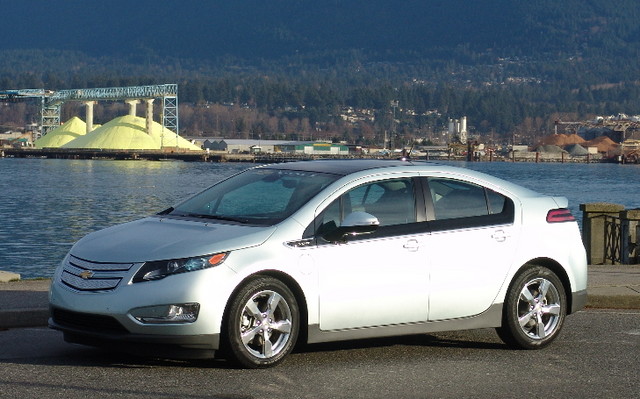Chevrolet Volt: Get a charge out of it!
At the 2007 Detroit Auto Show, Chevrolet unveiled the Volt, a new kind of hybrid car. Indeed, after noticing that most people travel no more than 65 km (40 miles) per day, mainly to go to work and back, the brass at Chevrolet conceived an electric car that could be plugged in and that could cover this distance on a single charge.
The biggest problem with electric cars is that when the batteries are drained, the trip is over, period. But GM, recognizing this fact, gave its Volt a gasoline engine that, combined with a generator, provides electricity to the batteries to recharge them. This engine doesn’t drive the front wheels, so we’re not talking about a hybrid vehicle here.
The Volt is an electric car.
General Motors developed the Volt more than three years ago. For the Vancouver Winter Olympic Games (+15 degrees in winter!), GM brought out two prototypes of the Volt. Several other prototypes are undergoing testing in the cold of the GM’s Cold Weather Test Centre in Kapuskasing, Ontario, or sweating it out under the hot sun of the southern United States. Strangely, and contrary to popular opinion, heat is a lot more damaging to batteries than cold!
T-shaped battery
The Chevrolet Volt’s main feature is, indisputably, its battery pack. These batteries, whose cells are made by LG Chem and assembled in a new GM plant in Brownstown, Michigan, are arranged in a T shape. The long part separates the passenger compartment in two and the short part is under the back seat to ensure the most space possible in the passenger compartment. There are no less than 288 3.5-volt cells in this battery. The lithium-ion battery has a 16 kW/h capacity and weighs 180 kilos. Completely discharged, it can be recharged in about eight hours with a household 120-volt outlet or more quickly with a 240-volt outlet.
The electric motor also constitutes one of the Volt’s most important features. It produces a power equivalent to 150 horsepower and 273 lbs-ft of torque, which guarantees the car lively accelerations and, according the Volt’s engineers, a 9.0-second 0-100 km/hr time. This seems realistic to us, as does the maximum speed of 160 km/hr.
A gasoline engine for an electric car!
As for the gas engine, it’s a four-cylinder Ecotec, but we don’t yet know how much power it has. This engine’s only purpose is to recharge the battery. Thus, it’s possible that during the entire life of a Volt, its gas engine may never have to start! In theory anyway... In practice, it will start about every two months, whether the battery is dead or not. Firstly, you have to make sure that its components don’t jam or don’t deteriorate due to an excessively long period of inactivity. The second undoubtedly more important reason is rather ironic... Since the Volt has a gas engine, American authorities, and Canadians authorities as well I imagine, places controls on noxious emissions by way of the onboard computer. Chevrolet must be able to prove that the gas engine of each Volt is respecting the emissions levels, and the only way to do that is to emit! As I was writing this article, GM didn’t know if this four-cylinder was going to take regular or super gas.
The guideautoweb.com team recommends that GM use the first option... To make sure that this motor functions as infrequently as possible, the energy expended by the brakes is recovered and sent to the battery. Determining the average gas consumption is no easy task. You won’t need any at all for the first 65 km, then, according to GM, the average should be about 1 litre/100 km although higher fuel consumption has to be expected if temperature or driving conditions are not optimal. You should note that the 65 km distance travelled solely on battery power is also theoretical. A lead foot or a less than ideal temperature could shorten those 65 kilometres!
A telltale test drive, more or less
A test drive with a prototype isn’t nearly as revealing as a test drive with a production or even a pre-production model. Thus, it’s difficult to talk about vehicle handling when we tested the car in Vancouver’s Stanley Park where the speed limit is 30 km/hr! First of all, there’s nothing out of the ordinary with this very unique car’s handling, although the stick shift looks like it came straight out of a science fiction film. It has a Start-Stop button, which is becoming more and more common, for ignition. From the start, you’ll notice how quiet it is since you’re driving in electric mode only. However, you’ll hear various other sounds (tires, wind, etc.) more.
Among the outcrop of buttons on the very pretty dashboard is a Sport button that gives a little boost to the car when you feel the need. In normal circumstances, the electric motor provides 90 kW but when the Sport button is pushed, it delivers its 110 kW maximum. The difference, while not overly obvious, remains perceptible nonetheless. When the batteries are dead (or just before dying actually!), the gasoline engine starts. When that happens, you hear kind of a melody, and then, when the passenger compartment is silent, the sound of the engine is audible.
As for the ride, it isn’t unduly exciting. A longer test drive on normal roads would tell us a lot more. The seats seemed comfortable, even though the leg room is rather limited for those in the back. The trunk, unlike what can be found in many hybrid cars, is not reduced by the presence of the battery and you can even lower the seatbacks to increase its capacity. Like the Toyota Prius and Honda Insight, the window on the hatch is divided by a horizontal bar, affecting rear visibility of course.
The version of the Chevrolet Volt that we test drove is going to undergo improvements and will be developed further. As such, when another generation of more powerful batteries is offered, the engineers will be faced with a dilemma. Reduce the size of the battery and accommodate five passengers, or very simply increase the range. And it’s not a given that the Volt will forever keep its gas engine either. They’re already talking about a diesel engine, or even, in a more distant future, a fuel cell. And then, the Volt’s current system may just find itself in other vehicles.
Dollars and cents
One of the most common questions about hybrid and electric cars deals with battery life and battery replacement cost. In the Volt’s case, the battery will last about twelve years and the current replacement cost is $16,000. Careful, don’t panic… Once the battery is no longer good for the car, it’ll still be okay for other applications, such as energy storage for a wind turbine on a farm, for example. So, over the years, a used battery market will develop. With the costs lowering as the quantity of batteries increases and this second hand market, there’s a very good chance that in ten years, a new battery will be only two or three thousand dollars. But if it’s more, I will deny writing this paragraph...
The Volt is nothing less than the future of General Motors, both mechanically and in terms of image. Detroit’s less-giant-than-before-but-still-giant has no margin for error. The price, a crucial point if there ever was one, has not yet been set and the engineer who answered our questions was clearly uncomfortable talking about it. However, I propose a price of about $40,000 for the first units sold in Canada, the 2012 models, coming out in the spring of 2011. In the United States, certain target markets may get the Volt this fall. They will be 2011 models.












